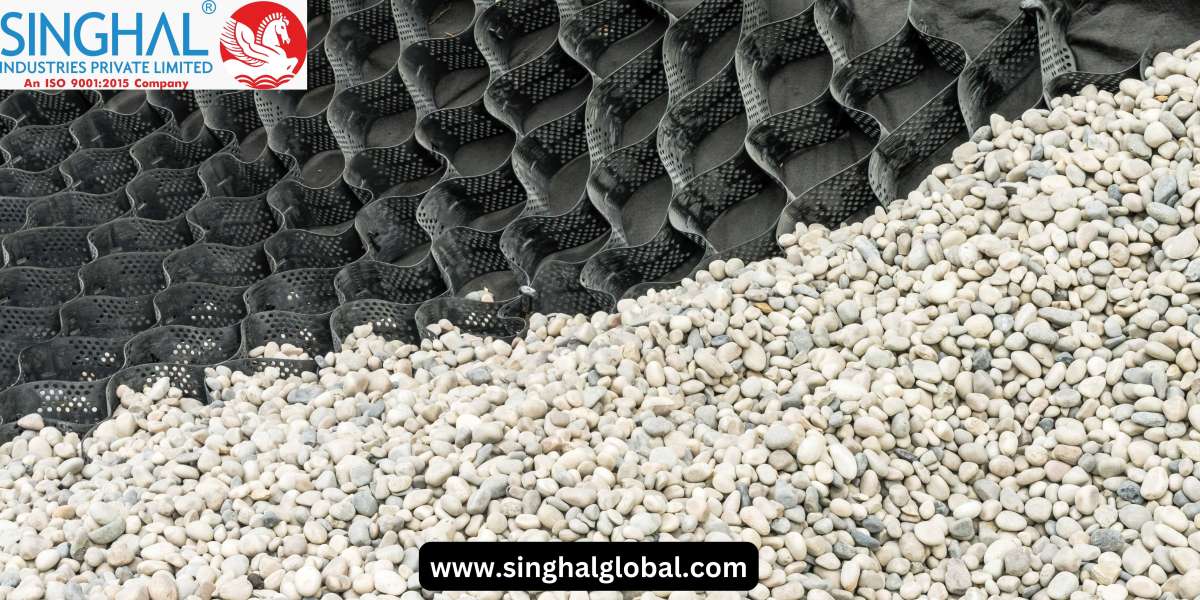Geocell technology has emerged as a groundbreaking solution in the field of geotechnical engineering, offering remarkable advantages in soil stabilization, erosion control, and structural support. As the construction and infrastructure industries continue to evolve, the demand for innovative materials that enhance performance and longevity is at an all-time high. Among these innovations, Geo cell membrane manufacturers in Gujarat have gained considerable attention for their ability to significantly improve the strength and durability of various applications, ranging from road construction to landfills and more.
In this article, we will explore the intricacies of geocells, including their composition, applications, and benefits. Additionally, we will delve into the role of Geocell manufacturers in India, with a particular focus on Gujarat and Ahmedabad, two key regions in the manufacturing landscape.
What Are Geocells?
Geocells, also known as geocell membranes, are three-dimensional, honeycomb-like structures made from high-density polyethylene (HDPE) or other geosynthetics. These structures are designed to expand horizontally when laid flat and can then be filled with materials like soil, gravel, or concrete. The primary function of geocells is to reinforce weak or unstable soils, providing structural support for heavy loads and preventing erosion in areas prone to washouts or flooding.
The unique design of geocells provides excellent lateral confinement, which enhances the strength of the filled material and reduces the likelihood of settlement, deformation, or displacement over time. Geocells are typically used in applications where traditional geotechnical solutions, like compacted soil or soil stabilization methods, may not provide the necessary support or durability.
Applications of Geocell Technology
Geocells offer a versatile range of applications across multiple industries. Some of the most common uses of geocell technology include:
- Road Construction: Geocells are widely used in road construction, particularly in areas with weak or unstable soils. By distributing the weight of traffic over a larger area, geocells reduce the risk of rutting and surface degradation. They help in creating durable and long-lasting roadbeds, especially in regions with low-bearing capacity soils.
- Slope Protection and Erosion Control: Geocells are highly effective in preventing soil erosion on steep slopes, riverbanks, and embankments. By stabilizing the soil and preventing surface runoff, they offer significant protection against erosion caused by water, wind, and other environmental factors.
- Landfill and Waste Management: Geocells are used in the construction of landfills and waste containment systems. The geocell structures provide an additional layer of support for the overburden and prevent landfill settlement. They are also used to prevent leakage and improve the overall integrity of waste containment systems.
- Ground Stabilization: Geocells are an ideal solution for stabilizing weak or expansive soils. By reinforcing the soil matrix, they prevent differential settlement, making them suitable for foundations, pavements, and other applications that require stable ground conditions.
- Retaining Walls: Geocells can be used to construct retaining walls in areas where traditional concrete or stone walls would be impractical. Geocell manufacturers India walls are not only cost-effective but also more flexible and resistant to shifting or settling over time.
Key Benefits of Geocells
- Cost-Effectiveness: One of the major advantages of geocells is their cost-effectiveness. Compared to traditional soil stabilization and reinforcement techniques, geocells offer a more affordable solution without compromising on performance. The materials used in geocell construction are lightweight, reducing transportation costs and making installation faster and easier.
- Improved Load Distribution: Geocells provide superior load distribution by spreading the weight over a larger area. This reduces the stress on the underlying soil, preventing excessive settlement and ensuring the longevity of structures like roads and foundations.
- Enhanced Durability: Geocells are designed to withstand harsh environmental conditions, including high temperatures, moisture, and UV radiation. Their resistance to these factors ensures that geocell-reinforced structures maintain their strength and functionality over time.
- Environmental Benefits: Geocell technology promotes environmental sustainability by reducing the need for natural resources like gravel, stone, and cement. Additionally, by preventing soil erosion, geocells help preserve the surrounding ecosystem and prevent degradation of valuable land.
- Flexibility: Geocells can be easily adapted to various applications, from erosion control to heavy load-bearing structures. The ability to customize geocells based on the specific needs of a project makes them a highly versatile solution in geotechnical engineering.
Geocell Manufacturers in India: Key Players and Trends
In India, geocell technology is gaining traction, and several manufacturers are providing high-quality geocell products to meet the growing demand for soil reinforcement solutions. One of the leading regions for geocell production is Gujarat, home to some of the most prominent geocell membrane manufacturers.
Geo Cell Membrane Manufacturers in Gujarat
Gujarat is known for its strong manufacturing base, and the geotechnical industry is no exception. Several companies in the region specialize in the production of geocells, catering to both domestic and international markets. These manufacturers are committed to providing durable, reliable, and cost-effective geocell products for a variety of applications, from road construction to landfill stabilization. By leveraging advanced technology and innovative manufacturing processes, Gujarat-based geocell manufacturers ensure that their products meet international quality standards.
Geocell Manufacturers India
Across India, geocell manufacturers are playing an essential role in the development of infrastructure projects that require reliable soil stabilization solutions. With the rising demand for geotechnical products, Indian manufacturers are continually enhancing the quality and versatility of their geocell products. They are also focusing on eco-friendly solutions and providing customized geocell designs to meet the specific requirements of their clients.
Geocell Manufacturers in Ahmedabad
Ahmedabad, the commercial and industrial hub of Gujarat, is home to several renowned Geocell manufacturers in Ahmedabad. These companies are known for their cutting-edge production facilities and expertise in geotechnical engineering. By combining local expertise with international best practices, geocell manufacturers in Ahmedabad are helping to meet the diverse needs of industries such as road construction, landfills, and erosion control.
Conclusion
Geocell technology is transforming the landscape of modern infrastructure, providing efficient and cost-effective solutions for soil stabilization, erosion control, and structural reinforcement. As demand for geocells continues to rise, regions like Gujarat and Ahmedabad are becoming key players in the global market, offering innovative products to meet the needs of construction professionals worldwide. Geocell manufacturers in India are paving the way for sustainable and durable infrastructure, making geocell technology an indispensable tool in the construction and geotechnical industries.
Frequently Asked Questions (FAQs)
- What are the environmental benefits of using geocells in construction projects?
Geocells offer significant environmental benefits. They reduce the need for traditional construction materials like gravel, concrete, and cement, helping conserve natural resources. Moreover, geocells are highly effective in preventing soil erosion, which can lead to land degradation and ecosystem disruption. Their ability to stabilize soils also reduces the need for extensive excavation or land alteration, preserving the surrounding environment.
- How do geocells improve the load-bearing capacity of weak soils?
Geocells work by confining the soil within their honeycomb-like structure, which helps distribute the weight of the load more evenly across a larger area. This reduces stress on the soil and prevents it from sinking or deforming. The reinforcement provided by geocells ensures that the underlying soil remains stable, even under heavy loads, making them ideal for applications like road construction and foundations on weak or expansive soils.
- Can geocells be used in both urban and rural construction projects?
Yes, geocells are versatile and can be used in both urban and rural construction projects. In urban areas, they are commonly used in road construction, foundation stabilization, and slope protection. In rural areas, geocells are often employed in erosion control, agricultural land stabilization, and the development of rural infrastructure. Their adaptability makes them suitable for a wide range of applications in various environments.







